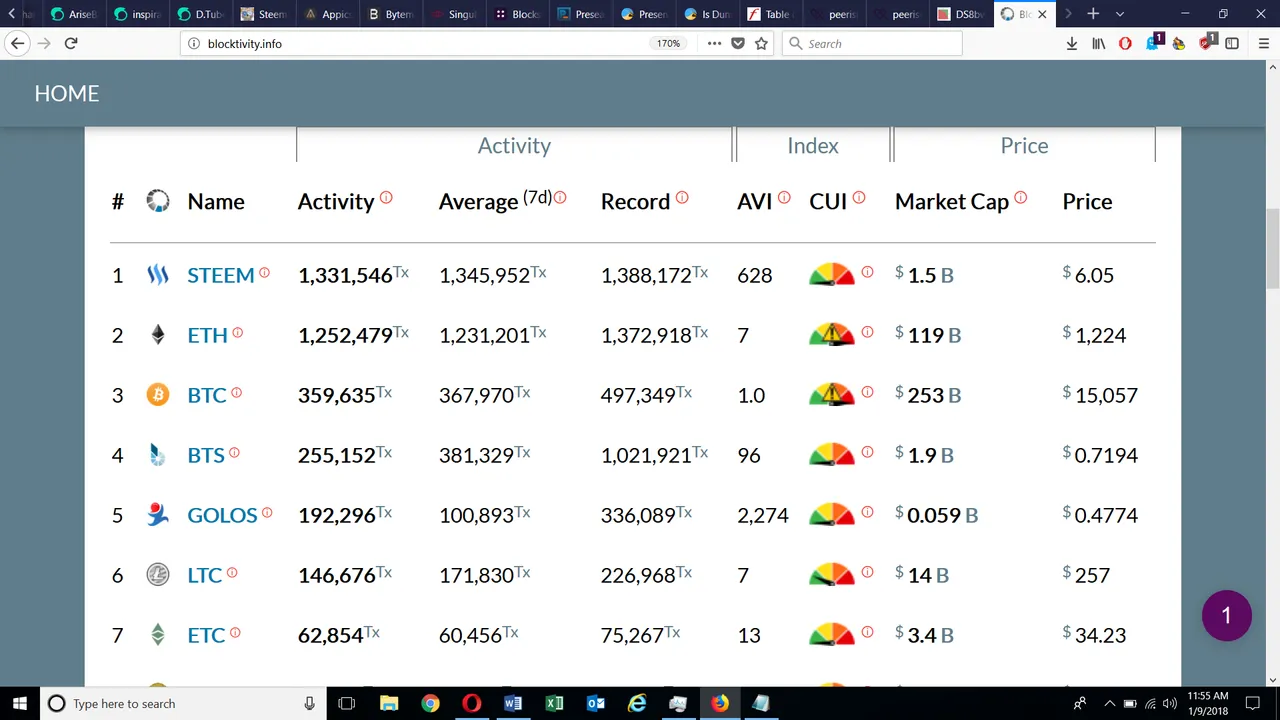
Okay, I have to admit that I might be biased in my conclusion although the evidence does seem to support this.
I read an article last night that detailed how the author thought that blockchain innovation was being stifled. This person's conclusion was based upon the fact that the fees for both the Bitcoin and Ethereum blockchains has skyrocketed of late. What this does is make many apps useless since the fees deter people from using them. A central premise for microprocessing is obviously limited-to-no fees. We do not see this on those blockchains.
Now I am not certain that I agree with this premise entirely since I view it as a temporary situation. My personal feeling is that the Bitcoin and Ethereum people will figure it out. It might take them a while but there are simply too many highly intelligent developers working on those blockchains.
So why do I say that Steem is leading out of the gate? Is it because it has more transactions than on average than anyone else? Or could it be the fact that development is occurring on this blockchain at such a rapid rate? Maybe it is the applications that are being created on here?
It is none of those answers although they are valid. The number of transactions show this is already a thriving blockchain with more activity than any other one. That gives a lot of validity to what is taking place. As for the development, Bitcoin still has more developers than any other blockchain. At the same time, because of all the tokens created, Ethereum is in the lead in the app arena, at least in terms of number created.
The reason why Steem is ahead of all others, and could remain there, is fees and scaling.
This is at the core of the issues that the other blockchains are facing.
So if you’re trying to build anything even remotely high-volume atop an Ethereum token — forget it. Your entire business model is catastrophically doomed at today’s prices.
As a result, entire categories of cryptocurrency experimentation and innovation are on hold until the bubble bursts, or until / unless Ethereum finds a way to scale such that transaction fees plummet. Oh, people can still write and deploy code. But nobody will use it. Curious would-be users will be repelled by the nontrivial expense of mere experimentation, never mind ongoing usage.
We all know that both Bitcoin and Ethereum are bogged down with the traffic. What is ironic is they are both in this state while charging high fees. So obviously, most people are not turned away at the moment. Why would that be? Perhaps it is because of a lack of choice. These two blockchains had so much development early on that they became the de facto networks. Hence, the people in Venezuela are using Bitcoin in spite of the high fees simply because there isn't a viable, wide-spread alternative.
For the state of the blockchains pertaining to usage:

As you can see, Steem is blasting out 1.3M transactions a day and not even breaking a sweat. For the foreseeable future, there is not a scaling problem. This gives it a huge advantage over the other blockchains who really have to determine how they are going to get rid of the bottlenecks. While I believe they will accomplish this, it will take them some time. All the while, Steem is steaming ahead.
It remains an open question whether even much, much lower fees would be viable in the long run. Proponents of micropayments don’t seem to realize that the fundamental problem with micropayments is not their cost, or the absence of supporting infrastructure; it’s the cognitive load that they induce. Parker Thompson of AngelList argues that fee-free decentralized apps are the only ones which might possibly succeed in consumer markets, and I think he’s right, but that raises the question of how you prioritize and prevent spam blockchain transactions in the absence of fees.
This brings up the major point of contention the author had which is very valid. How will these systems handle the fee structure? Will people be willing to make a payment on a small transaction. Consider some of the upvotes on Steemit that are only worth a few cents. This has a payout of .005 SP or so. How would you like to earn that except it costs 25 cents to send the money to you? Imagine having your account deducted to pay the transaction fees.
Fortunately, this is not a problem on the Steem blockchain since it is a fee-free system. All transactions cost zero (bandwidth is the only thing that is required). Contrast that with the other two blockchains and, even, Litecoin which promotes itself as low-fee. Low-fee is not no-fee. Simply put, there is no contest.
Let me post a piece of that again:
Parker Thompson of AngelList argues that fee-free decentralized apps are the only ones which might possibly succeed in consumer markets,...
This might be the exact reason why Steem will keep separating itself from the other blockchains over the next few years. While the other networks are focusing upon scaling up and getting their fees down, Steem simply offers a viable alternative to developers. If you are creating an app that you hope to go mainstream, as is stated here, the greatest chance of success is to be fee-free. The way I see it, developers are rather limited in their choice of blockchain if this is a necessary criteria.
For full story:
https://techcrunch.com/2018/01/07/the-cryptocurrency-bubble-is-strangling-innovation/
@arcange issues his daily report detailing the numbers on the Steem blockchain. The graph I like to watch is this one.

We hit 60,000 daily active users plus 30,000 authors. That is an impressive growth rate. Of course, this only verifies what the daily transactions already confirm. However, in my view, it takes it one step further showing the activity is widespread. This is not a situation where a few people are doing many transactions. There are now 60,000 people engaging upon activity on this blockchain, a number that I expect to keep growing.
For his full report:
https://steemit.com/statistics/@arcange/steemit-statistics-20180108-en
So in short, Steem has:
-Zero transaction fees
-1.3M transactions per day with the ability to handle millions more
-60K users and growing
-30K authors posting articles
-An increasing standing in the search engines (organic traffic)
-A rising token price which increase the payouts in the reward pool (in dollars at least)
All this without a major application added, communities implemented, HF 20 taking place, or SMT being operational. Can you imagine what this place will look like when all that is put into place?
Steem is quickly putting itself at the forefront as one of the leading blockchains. In addition, while it is impossible to predict the future exactly, I am making the case that it is possible for Steem to keep advancing ahead of the other ones. The fact that there it is fee-free for transactions gives Steem an advantage that others cannot get around. This has to hold a lot of attractiveness to developers.
How will this play out? Ultimately, I am guessing to the benefit of Steemians.
If you found this article helpful, please upvote and resteem.
To be receive the free basic income tokens you are entitled to and help end world wide poverty, please click the following:

Pictures by Google Images